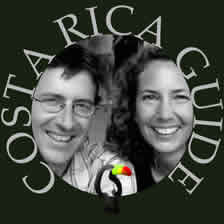The normal flow of traffic in Costa Rica is often moving at around two to three times the speed limit which can make it extremely dangerous to abide by the law. If you slow down to 25 kph (15 mph) in the school zones on the Pan American Highway you may be rear ended by someone going 100.
An even bigger risk in obeying the speed limit comes from the insane behavior it induces in other drivers. If you’re going that slow they will pass you on a double yellow line, uphill around a blind corner and there’s a reasonable chance of a couple of cars coming the opposite direction doing the same.

Even though speeding fines are several hundred dollars it may be more prudent to try to stay closer to the flow of traffic that strictly obeying the speed limits…it’s sort of a situation of your money or your life.
Generally the lower the speed limit the more people speed. In the example above of school zones on a highway the average speed is probably 75 kph or triple the speed limit.
The whole northern stretch of the PanAmerican highway from Cañas to Liberia is under construction to widen the road from one lane each direction to two lanes with bike paths, sidewalks and bus stops. The construction zone speed limit is 30 kph (just under 19 miles per hour) but the average speed of traffic is around 80 kph which is the normal posted speed limit when there’s no construction.
Use your best judgement.
No Passing Zones
Enforcement of no passing zones has increased because following pedestrian fatalities, head on collisions in no passing zones are the main cause of traffic deaths in Costa Rica.
However, there are some situations where you almost have to pass (and again like speeding everyone else does, even little old ladies on their way to church)
When you’re following a tractor pulling a sugar cane cart at 5 kph (3 mph) it could be 30 or 40 minutes before they turn off or you reach a dashed yellow line indicating you can pass legally. It’s pretty obvious that you carefully pass regardless of the double yellow line. But, what about a pineapple truck at 17 kph (10 mph)? How about a semi going 37 km per hour (23 mph)? Should you risk an $800 fine to pass?

We haven’t ever been pulled over for it but a friend was and he got a really nasty surprise when he found out that the fine is per vehicle passed so the two trucks he went around cost him $1,600.
Safe and Sane
We generally don’t try too hard to determine the technical legality and simply do what seems safe and reasonable. We also drive the biggest SUV we can find and make sure it has as many airbags as possible because we know there are a lot of insane drivers headed our way.
Sometimes it’s impossible to figure out what’s legal. We’ve seen the velocidad maxima posted on a sign as 60, right next to a velocidad maxima of 45 painted on the road (speed limits are often painted as big numbers on the asphalt because it’s cheaper than a sign) in a school zone where technically the law says the limit is 25. In fact I once stood on an 80 next to a sign that said 60 and talked my way out of a ticket the traffico was going to write because he said the limit was really 45 because there was a gravel road entering the highway 100 meters away (the limit is 45 within 100 meters of all intersections…).
The poor maintenance of roads in Costa Rica means that there are many stretches where the lines wore off years ago (if they were ever there). It’s impossible to know where the passing zones are but don’t think that will save you if you get pulled over. If there used to be a double yellow line painted there you’re probably going to get a citation and it will definitely hold up in court should you decide to spend the year or two it might take to challenge it.
